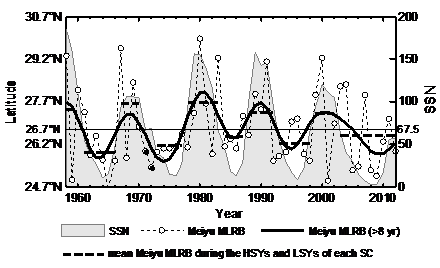State Key Laboratory of Numerical Modeling for Atmospheric Sciences and
Geophysical Fluid Dynamics (LASG)
Institute of Atmospheric Physics, Chinese Academy of Sciences

Vol. 2/No.2 April 2017
[Climate Dynamics]Amplification of the Solar Signal in the Summer Monsoon Rainband in China by Synergistic Actions of Different Dynamical Responses
Highlights:
The climatological-mean East Asian generalizedmei-yu season, characterized by a largescale quasi-zonal monsoon rainband, is identified as the most sensitive stage within the summer half-year to the 11-yr solar cycle.
The dynamical responses of the lower tropical monsoon and the upper subtropical westerly jet to the 11-yr solar cycle transmit bottom-up and top-down solar signals, respectively, and the synergistic actions between the monsoon and the jet likely amplify the solar signal at the northern boundary of the monsoon.
A fingerprint ofthe sunspot cycle in rainfall or atmospheric patterns isconsidered possible in many studies.However, complex feedbacks within a climate system to solar forcing likely hinder the detection of the solar signal. If so, near the boundary of a regional climatesystem, solar signal should appear more evidently than that within it and is likely amplified. However, how the small 11-yr solar cyclesignal is amplified in the climate system is poorly understood.
Recently, Dr. Zhao Liang, Profs. Xiao Ziniu (LASG, Institute of Atmospheric Physics), Wang Jingsong (National Center for Space Weather, China Meteorological Administration) and Liu Haiwen (Department of Aviation Meteorology, Civil Aviation University of China) have found a possible pathway how the small 11-yr solar cyclesignal is amplified nearthe boundary regions of the East Asian summer monsoon.They first identified the exact time period within the summer half-year with the strongest response of the mean latitude of the rainband (MLRB) over China to the 11-yr sunspot cycle.This timeperiod just corresponds to the climatological-mean East Asian mei-yu season(i.e., 22 May–13 July; Figure 1 and 2), characterized by a largescalequasi-zonal monsoon rainband. Then they found the dynamical responses of the lower tropical monsoon and the upper subtropical westerly jet to the 11-yr solar cycle before and during the onset of monsoon transmit bottom-up and top-down solar signals, respectively (Figure 3).The coordinate and synergistic actions between the monsoon and the jet likely amplify the solar signal at the northern boundary of the monsoon to some extent.

Figure 1. Correlations between the annual sunspot number and the yearly mean latitude of the rainband (MLRB) series for any time span in the northern summer half-year (1 Apr to30 Sep). The shortest duration of the span is 1 day, and the longestspan is 183 days, in each year from 1958 to 2012. The x and y axesindicate the start and end dates of the span, respectively. Thecorrelation coefficients of the 95%, 99%, and 99.9% confidencelevels for the 55 yr are 0.26, 0.34, and 0.43, respectively.

Figure 2. Time series of annual sunspot number (shaded), the East Asian mei-yu season MLRB(dotted curve with circles), and 8-yr low-pass filtered East Asian mei-yu season MLRB (thicksolid curve) with its mean values (thick horizontal dashed lines) in the high and low solar years of eachsolar cycle between 1958 and 2012. The thin solid horizontal line denotes the mean sunspot number (67.5)and the mean mei-yu MLRB (26.7°N) for 1958–2012. The climatological generalized East Asian mei-yu season is the spanfrom 22 May to 13 Jul.


Figure3. Latitude–pressure vertical cross-sections of correlation coefficients between the (a) May SSN or (b) the June rainband meridional shift index (RMSI) of China and the MayEP flux (vectors) and May EP-flux divergence (color shading) or zonal wind tendency (ΔUJ–M; contours) along 115°E, respectively, for1901–2012. Absolute values more than 0.19 and 0.16 (> 95% and > 90% confidence levels) are shown by deep and light coloring for EP-flux divergenceor thick and thin contours for ΔUJ–M. Pink contours (labelled “JET”) are the 25-m s–1 mean zonal wind velocity in May (outer) and June(inner), respectively. The thick purple curves denote the 0-m s–1 meridional wind inJune, representing the northern boundary of the EASM. Norms of vectors for correlation between the SSN and May EP flux greater than 0.3 areshown.
Zhao Liang, Wang Jingsong, Liu Haiwen, Xiao Ziniu. Amplification of solar signal in summer monsoon rainband in China by a synergistic action of different dynamical responses. J. Meteor. Res., 2017, 31(1), 61-72, doi: 10.1007/s13351-016-6046-6.
Download:http://www.cmsjournal.net:8080/Jweb_jmr/EN/abstract/abstract1736.shtml
Zhao Liang, Wang Jingsong. Robust response of the East Asian monsoon rainband to solar variability. J. Climate, 2014, 27(8): 3043-3051, doi: 10.1175/JCLI-D-13-00482.1.
Download:http://journals.ametsoc.org/doi/pdf/10.1175/JCLI-D-13-00482.1
Contact: XIAO Ziniu, xiaozn@lasg.iap.ac.cn; ZHAO Liang, zhaol@lasg.iap.ac.cn
E-mail: lasg_newsletter@lasg.iap.ac.cn
Editors: Chuanyi Wang (wangcy@lasg.iap.ac.cn), Kangjun Chen(ckj@lasg.iap.ac.cn)